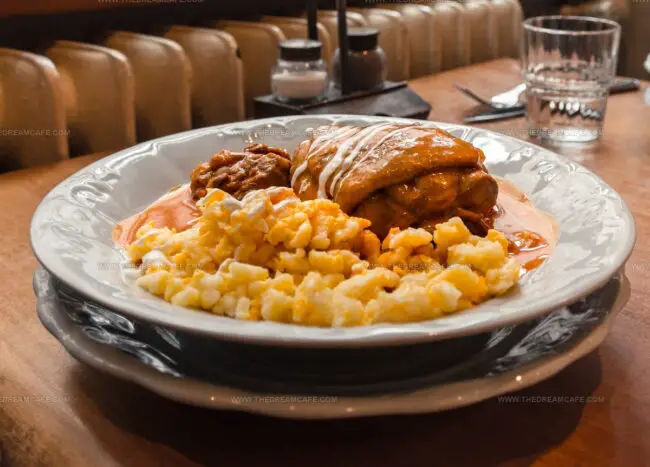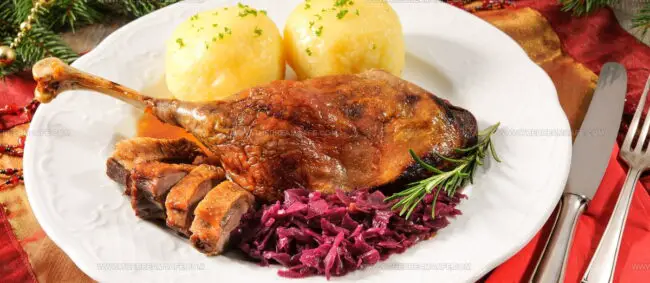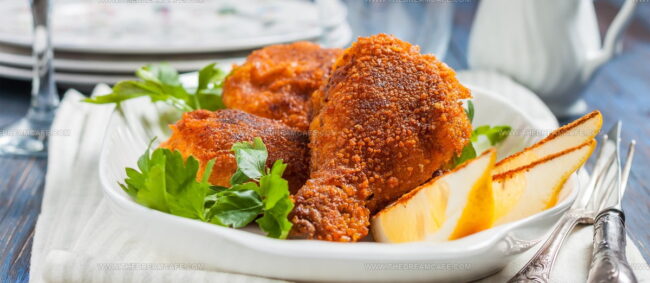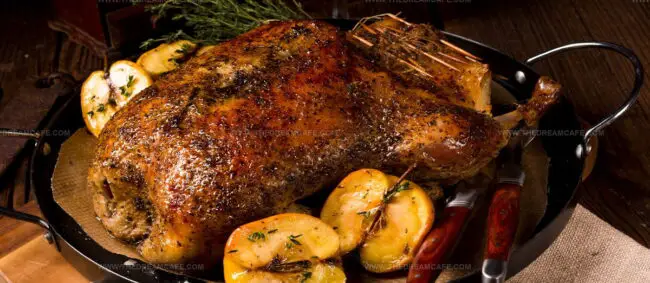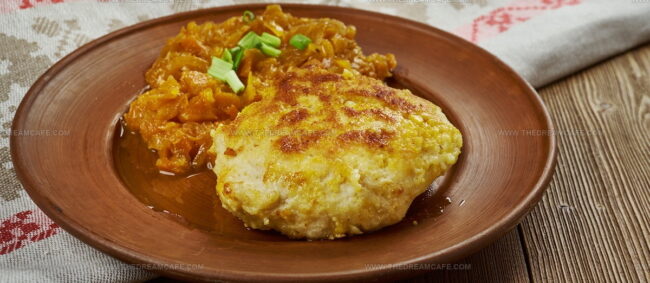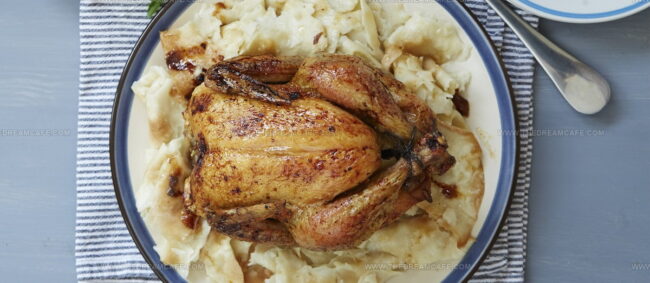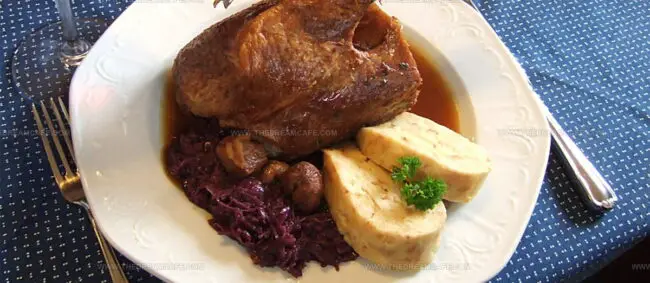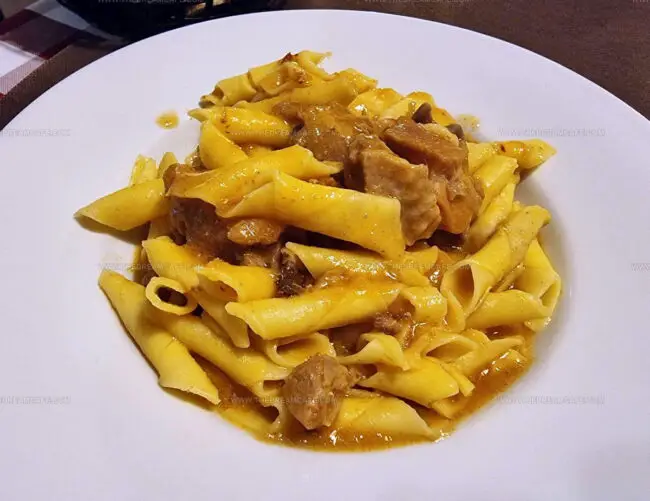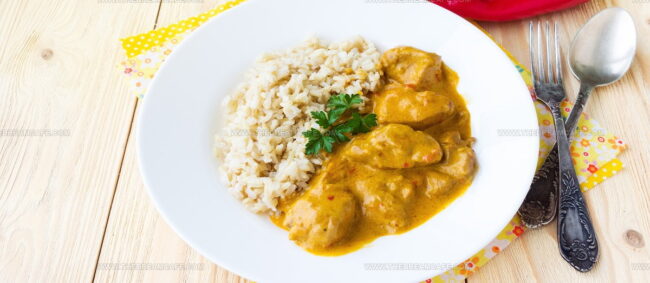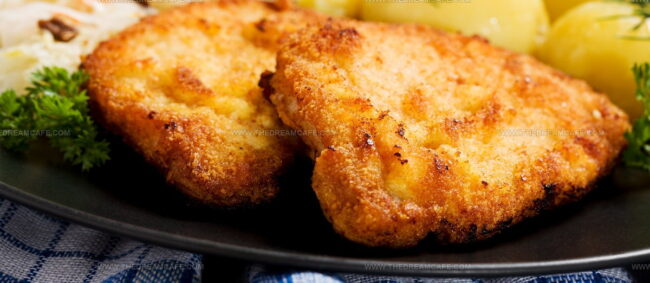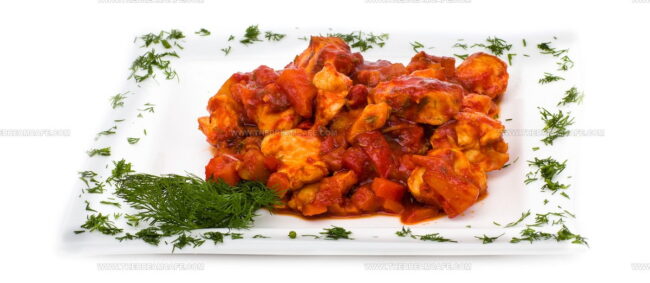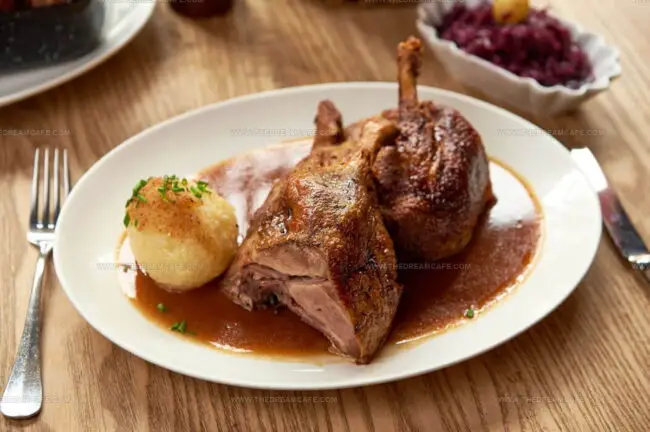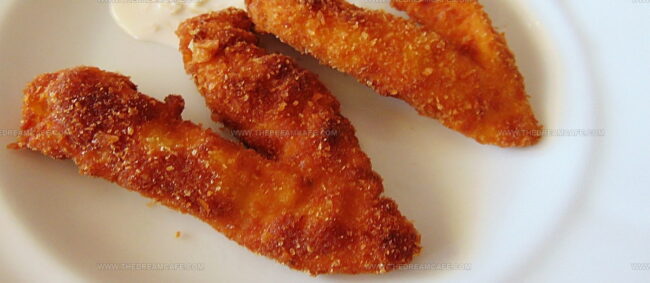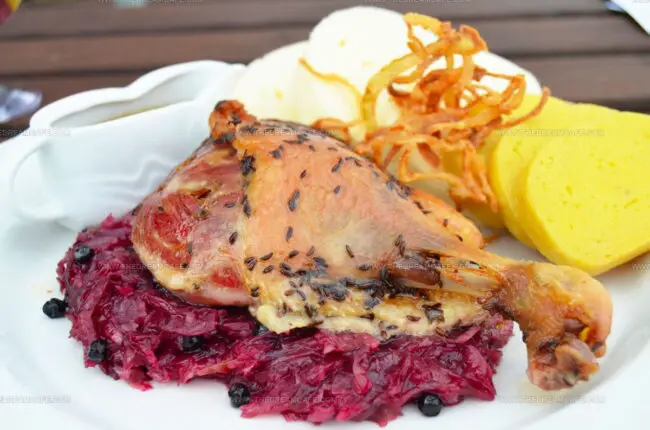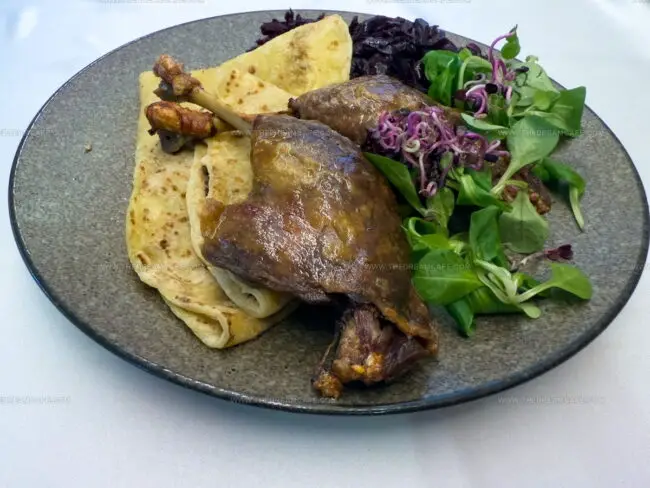32 Tasty Central European Poultry Dishes to Discover
Central European poultry dishes showcase a rich culinary heritage that transforms simple ingredients into mouthwatering meals.
Generations of home cooks have perfected techniques passed down through family traditions.
Regional spices and cooking methods elevate chicken, duck, and goose to extraordinary gastronomic experiences.
Robust flavors reflect the landscape's agricultural diversity and cultural influences.
Tender meats combined with hearty vegetables create comforting plates that warm both body and soul.
Culinary experts appreciate the nuanced preparations that highlight each ingredient's natural essence.
Rural and urban kitchens alike celebrate these time-honored recipes with passion and pride.
Ready to tantalize your taste buds with 32 popular Central European poultry dishes:
Popular Central European Poultry Dishes to Savor
Central European kitchens are renowned for their poultry dishes, slow-cooked and full of flavor. Expect classic roasts, hearty stews, and recipes handed down through families.
Chicken Paprikash (Paprikas Csirke)
Hungarian chicken paprikas delivers a creamy, rustic stew bursting with rich paprika flavors and traditional countryside cooking techniques.
Hungarian shepherds and farmers originally prepared this dish in large cauldrons over open fires using simple, fresh ingredients.
Tender chicken thighs and legs are braised with sweet onions in a robust paprika-infused broth that creates deep, complex flavors.
Sour cream and occasionally flour transform the sauce into a silky, smooth texture that coats each tender meat morsel.
Authentic preparation requires careful layering of ingredients to maintain authentic Hungarian culinary traditions.
Regional variations might include different meat cuts or additional spices depending on family recipes.
Restaurants and home kitchens across Hungary continue serving this classic comfort meal with traditional side dishes like galuska dumplings or boiled potatoes.
Generations have passed down this beloved recipe, preserving its rustic charm and delicious simplicity.
Weihnachtsgans
Weihnachtsgans embodies a cherished German Christmas tradition of roasting a whole goose with rich, complex flavors.
German families prepare this festive dish by stuffing the bird with a mix of onions, prunes, chestnuts, apples, and sometimes dates or meat-based fillings.
Seasonal spices like thyme, marjoram, salt, and pepper enhance the goose's deep flavor profile.
Catholic holiday customs influenced this culinary practice, with roots tracing back to St.
Martin's Day celebrations on November 11th.
Historical records suggest the goose symbolized a celebratory meal marking the end of fasting periods.
Roasted to golden perfection, the goose emerges crispy on the outside and succulent inside.
Traditional side dishes like dumplings, spatzle, red cabbage, and gravy complement the hearty main course.
Each Christmas, families gather to enjoy this generations-old German feast that connects them to cultural heritage.
Wiesn Hendl
Wiesn Hendl is Bavaria's iconic roasted chicken, a simple yet flavorful dish featuring whole or half chickens grilled with minimal seasoning and brushed with melted butter during roasting.
Munich's famous Oktoberfest celebration highlights this beloved street food, where thousands of golden-brown chickens spin on massive grills for hungry festival attendees.
Beer gardens throughout southern Germany serve this classic dish, typically seasoned with just salt and occasionally fresh parsley.
Traditional accompaniments include crisp potato salad or massive soft pretzels called brezn.
German grillers carefully baste the chicken to ensure a perfectly crispy exterior and juicy interior.
Restaurant and festival visitors enjoy this straightforward protein as a satisfying meal paired with local beer.
Bavarian culinary traditions have preserved this grilled chicken recipe for generations.
Regional cooking methods emphasize high-quality ingredients and simple preparation techniques that allow natural flavors to shine.
Gansebraten
Gansebraten embodies Germany's winter feast tradition, showcasing a whole roasted goose prepared through meticulous brining and seasoning with aromatic herbs like marjoram, thyme, and nutmeg.
German families cherish this festive dish, typically roasting the bird until its skin turns golden and crispy while stuffing it with apples, onions, and chestnuts.
Holiday tables feature this rich, succulent meat accompanied by classic sides such as braised red cabbage, potato dumplings, and apple puree.
Roasted slowly to ensure tender meat and crisp skin, gansebraten represents a cherished culinary experience deeply rooted in German seasonal celebrations.
Salt and herbs penetrate the meat during brining, creating complex flavor profiles that make each bite memorable.
Regional variations exist across Bavaria and other German regions, with some families passing down specific preparation techniques through generations.
Traditionally served during autumn and winter months, gansebraten connects modern Germans with their cultural culinary heritage.
Roasted Duck (Pecena Kachna)
Pecena kachna are golden-brown roasted ducks from Czech Republic with crispy skin and tender meat that embody traditional Central European culinary excellence.
Seasoned generously with caraway seeds and marjoram, these ducks slowly roast in ovens until achieving perfect caramelization and rich flavor profiles.
Czech families typically prepare this dish during weekend gatherings or special celebrations as a hearty main course.
Restaurants across Czech regions serve pecena kachna alongside classic accompaniments like bread dumplings, roasted potatoes, and braised red cabbage.
Chefs carefully render duck fat during roasting to create a thick, flavorful sauce that complements the meat's richness.
Generations have passed down recipes for this beloved national dish through family kitchens and traditional cookbooks.
Each roasted duck represents a careful balance of spices, cooking techniques, and cultural pride.
Regional variations might include subtle differences in seasoning or preparation methods that reflect local culinary traditions.
Backhendl
Backhendl is an Austrian crispy golden-brown chicken dish originating in Vienna during the 18th century, beloved throughout the Biedermeier period.
Habsburg nobility first popularized this elegant meal featuring small whole chickens carefully seasoned with lemon and spices.
Chefs traditionally debone the entire chicken before cutting it into specific pieces for precise preparation.
Cooking involves dipping chicken segments in egg wash, rolling them through flour, and coating with breadcrumbs before deep frying to achieve a perfectly crunchy exterior.
Austrians often serve backhendl alongside traditional fried chicken offal like liver and heart.
Historical records suggest this recipe emerged from royal kitchens and quickly spread across Viennese dining tables.
Regional variations exist throughout Austria, with some families maintaining unique seasoning techniques.
Southern Austrian regions particularly enjoy adding specific herb blends to enhance the chicken's flavor profile.
Apple-Stuffed Duck (Kaczka Z Jabkami)
Roasted duck with apples embodies a classic European culinary tradition blending sweet and savory flavors through perfectly prepared poultry.
German and French cuisines particularly celebrate this dish as a festive meal combining tender meat with fruity complexity.
Skilled cooks carefully season the duck with salt, pepper, and herbs before stuffing it with fresh apple slices that infuse rich, aromatic notes during roasting.
Crispy skin develops as the duck bakes, creating a golden-brown exterior that seals in succulent meat juices.
Apple varieties like Granny Smith or Golden Delicious work best for providing balanced tartness and softness inside the roast.
Traditional side dishes include roasted potatoes, stewed cabbage, or additional caramelized apples drizzled with meat drippings.
Restaurants and home kitchens alike feature this elegant dish during special occasions and autumn celebrations.
Regional variations across European countries add unique spices and preparation techniques that enhance its classic flavor profile.
Kotlet Z Piersi Kurczaka
Kotlet z piersi kurczaka embodies Poland's beloved comfort food tradition with its perfectly crispy exterior and juicy chicken interior.
Polish families create this classic dish by pounding chicken breasts extremely thin to ensure quick, even cooking and maximum moisture retention.
Cooks prepare the cutlets by coating them first in flour, then dipping them in beaten eggs, and finally covering them with golden breadcrumbs.
Each cutlet gets deep-fried until it reaches a beautiful golden-brown color and develops a satisfying crunch.
Home kitchens and restaurants across Poland serve these breaded chicken cutlets as a standard dinner main course.
Traditional accompaniments include boiled or mashed potatoes, fresh vegetables, and sometimes rice.
Generations have enjoyed this simple yet delicious meal as a staple of Polish home cooking.
Regional variations might include slight changes in seasoning or breading techniques, but the core preparation remains consistent throughout Poland.
Turkey With Mlinci (Purica S Mlincima)
Zagorski turkey with mlinci represents a traditional Croatian feast starring a whole roasted turkey accompanied by unique unleavened flatbread-pasta hybrid.
Croatian farmers in Zagorje region developed a special turkey breed after Italian Pauline Fathers introduced the bird in the 15th century.
Native Zagorje turkeys boast exceptional meat quality from specific regional breeding practices.
Mlinci transform from dry, crisp flatbread into softened carbohydrate accompaniment when soaked in rich roasting juices.
Regional cooks prepare the turkey by slowly roasting it until golden brown and crackling.
Meat drippings create a signature sauce that moistens the mlinci during serving.
Families typically enjoy this hearty meal during holiday celebrations and special gatherings.
Regional culinary traditions preserve this distinctive dish as a celebrated Croatian gastronomic experience.
Martinigans
Martinigans marks Austria's festive St.
Martin's Day celebration through a succulent roasted goose stuffed with chestnuts and dried plums, creating a rich culinary tradition.
Austrian families gather to enjoy this hearty seasonal feast centered around a perfectly prepared bird.
Roasting transforms the goose into a golden-brown centerpiece with crispy skin and tender meat.
Chestnut and plum stuffing adds depth and complexity to the flavor profile.
Accompanying side dishes typically include red cabbage, potatoes, or knodel dumplings.
Gravy made from giblet stock and pan drippings enhances the meat's richness.
Regional variations exist across different Austrian provinces.
Martinigans symbolizes autumn's bounty and community connection through shared seasonal eating.
Zgvacet Od Kokosi
Istrian zgvacet od kokosi stands as a rich Croatian stew featuring tender chicken pieces simmered in a robust tomato-based sauce with deep Italian culinary influences.
Croatian home kitchens frequently prepare this dish using chicken drumsticks and thighs that are carefully pan-seared before slowly cooking in a fragrant mixture of onions and tomatoes.
Originating from Italian guazzetto cooking techniques, the stew emphasizes slow simmering to develop complex flavor profiles.
Regional cooks traditionally season the dish with herbs and spices native to Istria's coastal landscape.
Mediterranean ingredients like olive oil and fresh garlic often enhance the stew's depth and character.
Families typically serve zgvacet od kokosi with crusty bread to soak up the flavorful sauce.
Regional variations might include additional vegetables or subtle spice adjustments.
Waterzooi
Waterzooi is a rich Belgian stew blending creamy sauce with tender protein, traditionally crafted in Ghent using fresh river fish before evolving to chicken-based variations.
Belgian kitchens transformed this classic dish when fish populations declined, adapting its recipe while maintaining its signature smooth texture.
Regional restaurants across Belgium now celebrate waterzooi's culinary heritage, featuring julienne vegetables and a velvety cream-based broth.
Generations have enjoyed this comforting meal, which begins with carefully sautéed ingredients and builds complex flavors through slow simmering.
Egg and cream form the stew's luxurious base, creating a silky consistency that distinguishes it from other regional recipes.
Ghent remains particularly famous for perfecting this beloved dish, attracting food lovers eager to taste its authentic preparation.
Fresh herbs and careful seasoning complete this deeply satisfying Belgian specialty.
Kure Na Paprice
Kure na paprice represents a savory Czech adaptation of Hungarian chicken paprikash, featuring tender chicken pieces braised in a luscious paprika-infused cream sauce.
Czech cooks enhance the traditional recipe by incorporating tangy tomatoes and varying sauce consistencies based on regional preferences.
Hungarian sweet paprika dominates the dish's flavor profile, creating a rich and warming meal that blends Central European culinary traditions.
Regional variations include different meat cuts and sauce preparations across Czech households.
Cream provides silky smoothness to the sauce, balancing the paprika's bold intensity.
Restaurants throughout Czech Republic feature this comforting meal as a staple winter menu item.
Prague and Bohemian regions particularly celebrate this cross-cultural chicken recipe that showcases paprika's remarkable versatility.
Kotlet Z Indyka
Kotlet z indyka is a classic Polish turkey cutlet breaded and fried to golden perfection, representing a staple meat dish in traditional Polish cuisine.
Polish families prepare these tender turkey slices by coating them in breadcrumbs and pan-frying until crispy and brown.
Cooks often enhance the cutlets by stuffing them with chopped ham, yellow cheese, and canned peppers before cooking.
Warsaw home kitchens and rural restaurants serve these cutlets as a hearty main course accompanied by classic side dishes like boiled potatoes, mashed carrots, or cabbage with dill.
Similar to traditional pork and chicken cutlet preparations, kotlet z indyka offers a versatile and satisfying meal option.
Regional variations may include different seasoning blends or additional filling ingredients.
Polish families typically enjoy these cutlets during weeknight dinners and weekend family gatherings.
Restaurant menus and home kitchens across Poland frequently feature this beloved turkey cutlet as a comforting and familiar dish.
Patka S Mlincima
Patka s mlincima represents a rustic Croatian feast featuring roasted duck and traditional flatbread, showcasing Northern Croatia's rich culinary heritage.
Zagorje and Meimurje regions celebrate this hearty dish where whole duck gets seasoned with salt and roasted with wine and fat drippings.
Mlinci, a unique handmade pasta crafted from flour, water, and sometimes eggs, transforms into a savory accompaniment during preparation.
Bakers first bake the mlinci, then soak them in boiling water before draining completely.
Cooks drizzle the flatbread with duck's roasting juices, creating an intensely flavorful side dish.
Duck meat becomes incredibly tender through slow roasting, ensuring a crispy skin and succulent interior.
Regional families traditionally serve this meal during festive gatherings and special celebrations.
Generations have preserved this authentic Croatian recipe, passing down cooking techniques that highlight simple, robust ingredients.
Katuv Sleh
Katuv sleh is a fiery Czech comfort food featuring tender meat swimming in a zesty tomato-cream sauce.
Czech households prepare this dish with chicken or pork as the primary protein, chopped onions, and colorful bell peppers adding depth and texture.
Regional variations showcase different spice levels and ingredient combinations across Czech kitchens.
Worcestershire sauce and chili provide a bold, tangy kick that elevates the entire meal.
Affordable ingredients make this dish a popular weeknight dinner option.
Restaurants and families alike enjoy serving katuv sleh with bread or potatoes to soak up the flavorful sauce.
Generations of Czechs have embraced this simple yet satisfying meal as a staple of their home cooking tradition.
Hong Am Reisleck
Hong am reisleck showcases Luxembourg's rich culinary tradition with tender chicken braised in a luxurious Riesling wine sauce.
Luxembourg's regional dish features chicken pieces expertly browned in butter and infused with a creamy sauce blending shallots, garlic, and mushrooms.
Wine lovers appreciate its sophisticated flavor profile from Riesling, which adds depth and complexity to the meal.
Chefs carefully combine chicken stock, heavy cream, flour, and egg yolks to create a silky sauce.
Cognac or sherry provides an additional layer of richness and warmth to the dish.
Mushrooms contribute an earthy undertone that complements the chicken's mild flavor.
Luxembourg families have enjoyed hong am reisleck for generations as a satisfying and elegant dinner option.
Gefullter Gansehals
Gefüllter Gänsehals is a rich German delicacy showcasing stuffed goose neck as a masterpiece of traditional meat preparation.
Bavarian and Austrian kitchens craft this intricate dish by carefully filling goose neck with a savory mixture of chopped goose liver, crispy bacon, and soaked bread rolls.
Skilled cooks season the stuffing with fresh parsley, bright lemon zest, salt, and pepper to enhance its complex flavor profile.
Goose fat provides additional richness when sautéing the stuffed neck with minced onions.
Precise preparation involves rinsing the neck, sewing one end closed, and creating a ground mixture of carefully selected ingredients.
Regional variations may include different herbs or spices depending on family traditions.
Served as a hearty main course, this dish represents centuries of German culinary expertise and regional cooking techniques.
Ente In Bier
Ente in bier reflects Germany's rich meat and beer culinary heritage, transforming duck through a complex braising method that infuses deep beer-based flavors into tender meat.
German kitchens traditionally prepare this dish by cutting duck into pieces and coating them with flour before browning in butter.
Dark beer provides a robust liquid base that slowly tenderizes the meat during simmering.
Chicken stock enhances the liquid's depth and complexity.
Aromatics like garlic, onions, lemon zest, thyme, and parsley contribute layers of flavor to the sauce.
Anchovy paste adds subtle umami undertones that complement the rich duck meat.
Marjoram introduces a gentle herbal note that balances the beer's intensity.
Careful reduction of the liquid creates a luxurious sauce that clings perfectly to the caramelized duck pieces.
Leteci Zganci
Leteci zganci emerges as a treasured Slovenian delicacy featuring crispy breaded chicken prepared through a meticulous coating process.
Originating in Ljubljana, this traditional dish transforms simple chicken wings and legs into a golden-brown culinary delight.
Cooks carefully wash the chicken pieces and season them with salt before creating a textured exterior.
Flour provides the first layer of coating, followed by a dip in beaten eggs.
Breadcrumbs create the final crispy shell that gives the dish its signature crunch.
Frying in hot oil ensures a perfectly browned and crunchy exterior that seals in the meat's juiciness.
Each piece develops a rich, golden color and satisfying crispness that makes the dish irresistible.
Generations of Slovenian families have enjoyed this straightforward yet flavorful chicken preparation as a staple meal.
Pohani V
Pohani V, a distinctive Croatian dish from Virovitica, showcases a chicken breast expertly sliced into a V-shape matching the city's initial letter.
Regional chefs carefully slice chicken breasts into precise V-formations before coating them with crispy breadcrumbs.
Skilled preparation involves pounding the meat thin and creating an exact geometric shape that honors the city's name.
Bread crumbs create a golden, crunchy exterior that contrasts with the tender chicken interior.
Croatian home cooks traditionally prepare this dish for family gatherings and special occasions.
Restaurants in Virovitica feature this signature recipe as a local culinary specialty.
Breadcrumb coating ensures a satisfying crunch with each bite.
Simple ingredients like chicken, eggs, flour, and breadcrumbs transform this dish into a memorable regional favorite.
Woihinkelche
Woihinkelche is a luxurious German chicken specialty from Rheingau's wine region that transforms simple ingredients into an elegant meal.
Regional white Riesling wine gives this dish its distinctive flavor profile and creamy richness.
Chicken pieces seasoned with salt, pepper, and tarragon create the foundation of this traditional recipe.
Chefs carefully brown the meat in a pan before adding chopped onions and garlic.
White wine deglazes the pan, creating a flavorful base for the sauce.
Fresh mushrooms and white grapes contribute subtle sweetness and complexity to the dish.
Cream whisked into the pan creates a silky, smooth sauce that coats the tender chicken.
Every bite reflects the culinary heritage of northern German wine country.
Turopolje-Style Goose (Guska Na Turopoljski Nacin)
Guska na turopoljski highlights Croatia's rich gastronomic heritage through a succulent roasted goose preparation from Turopolje region.
Regional farmers perfected this traditional feast dish by carefully roasting whole goose with minimal seasoning of salt and pork fat.
Slow roasting ensures the meat becomes incredibly tender and develops deep, complex flavors.
Chefs carefully baste the goose during cooking to maintain moisture and enhance its rich taste.
Side accompaniments include a hearty mixture of goose gizzards, liver, onions, and spices like garlic, cloves, and paprika.
Polenta flour adds substance to the complementary side dish.
Fat drippings create a luxurious base for additional seasoning and moisture.
Croatia's rustic cooking traditions shine through this simple yet flavorful regional specialty.
Rooster With Walnuts (Pijetao S Orasima)
Pijetao s orasima represents a hearty Croatian rooster dish from Zagorje region, featuring tender roasted meat enriched with a rich walnut sauce.
Local Croatian families traditionally prepare this specialty by seasoning a small rooster with salt and pepper before brushing it with pork fat.
Hot water helps create succulent meat during careful oven roasting.
Ground walnuts transform the roasted meat into a luxurious meal by forming a creamy sauce with butter, flour, and garlic.
Parsley adds fresh green notes to the complex flavor profile.
Meat juices blend seamlessly with the nutty sauce, creating a deeply satisfying main course.
Regional cooking techniques ensure each bite delivers authentic Croatian countryside comfort.
Pecena Raca Punjena Heljdinom Kasom
Pecena raca punjena heljdinom kasom embodies Croatia's rich regional cuisine through a succulent roasted duck stuffed with hearty buckwheat and aromatic ingredients.
Meimurje's signature dish features a whole duck carefully prepared with traditional spices and vegetables like carrots, celery, garlic, and onions.
Duck liver and hearts blend seamlessly into the buckwheat stuffing, creating a complex flavor profile that reflects local culinary traditions.
Pork fat adds richness to the roasting process, ensuring tender and juicy meat.
Salt and pepper enhance the natural flavors of the ingredients.
Regional cooking methods transform the duck into a crispy, golden centerpiece.
Meimurje's food culture shines through this rustic and flavorful specialty.
Picek V Kuruznoj Meli
Picek v kuruznoj meli embodies Croatian countryside cooking through its simple yet flavorful preparation of whole chicken coated in golden cornflour and baked in rich pork fat.
Regional cuisine from Meimurje celebrates this rustic dish featuring tender chicken pieces seasoned with salt and generously dusted with corn flour.
Pork fat provides a crispy, luxurious base that transforms ordinary chicken into a memorable meal.
Careful preparation involves cleaning and cutting chicken into uniform pieces before seasoning and coating thoroughly.
Croatian home kitchens traditionally bake this dish in hot ovens until the exterior turns a deep golden brown.
Rural cooking techniques emphasize minimal ingredients and maximum flavor in this straightforward recipe.
Cornflour creates a delicate, crunchy exterior that seals in chicken's natural juiciness.
Regional pride in traditional cooking methods shines through this uncomplicated yet satisfying meal.
Pevec Z Oreji
Pevec z oreji stands as a rustic Slovenian rooster dish with rich walnut sauce, highlighting traditional slow-cooking techniques from urevac.
Small young roosters form the protein base, carefully seasoned with salt and pepper before baking.
Pork fat greases the baking dish, ensuring moisture and deep flavor development.
Walnuts create a distinctive nutty sauce that transforms the roasted meat.
Butter and flour combine to thicken the sauce, adding complexity to the preparation.
Garlic contributes aromatic depth to the overall dish.
Roasting occurs slowly for approximately one hour, allowing meat to become tender.
Serving involves arranging rooster pieces in an earthenware dish and covering them with the warm walnut sauce.
Punjeni Kopun
Punjeni kopun represents a celebrated Croatian roast featuring a meticulously prepared stuffed rooster from Zagorje's culinary traditions.
Generations of Croatian families have cherished this hearty dish prepared with carefully selected ingredients including cleaned rooster meat, bread, fresh vegetables, parsley, and eggs.
Salt and pepper enhance the rooster's natural flavors during preparation.
Meat gets thoroughly cleaned before being stuffed with a rich mixture of bread crumbs, chopped vegetables, and herbs.
Regional cooking techniques ensure the rooster remains juicy and tender throughout roasting.
Traditional preparation methods involve precise seasoning and careful stuffing to maximize flavor complexity.
Croatian households typically serve punjeni kopun during special celebrations and festive gatherings.
Roasting transforms the bird into a golden-brown centerpiece that highlights regional Croatian cooking expertise.
Paprikas Od Kokosi
Paprikas od kokosi represents a rich Croatian chicken stew from Dugo Selo that combines local chicken with distinctive paprika flavors.
Croatian home cooks prepare this rustic dish by first boiling whole chickens in salted water until partially cooked.
Skilled cooks then cut the chicken into smaller pieces and sauté them in pork fat with chopped onions.
Red paprika powder - both hot and mild varieties - gives the stew its signature intense flavor and deep color.
Flour thickens the sauce after the spices are sprinkled over the meat.
Leftover cooking water creates a smooth, rich base for the stew.
Traditional preparation methods ensure tender meat and complex seasoning.
Regional ingredients highlight authentic Croatian culinary traditions.
Purica Na Lovranski Nacin
Purica na Lovranski nacin represents Croatia's rich culinary heritage from Lovran, featuring a whole turkey meticulously stuffed with a luxurious blend of roasted chestnuts, ground veal, and creamy ingredients.
Regional chestnuts provide the dish's signature flavor profile, creating a hearty main course that showcases traditional Istrian cooking techniques.
Cognac, rum, and prosek wine enhance the meat's complexity, adding depth and richness to each bite.
Egg yolks and butter contribute to the stuffing's smooth texture and intense flavor.
Ground veal creates a robust filling that complements the tender turkey meat.
Heavy cream binds the ingredients together, ensuring a moist and succulent result.
Local families have passed down this recipe through generations, maintaining its authentic preparation methods.
Lovran's exceptional chestnuts remain the cornerstone of this distinctive Croatian specialty.
Guscji Paprikas
Guscji paprikas is a hearty Slavonian and Baranjian stew bursting with rich goose meat flavors and deep cultural significance.
Regional cooks in Zupanja prepare this traditional dish by slow-cooking tender goose meat with sweet paprika powder.
Onions form the foundational flavor base, creating a robust and warming meal.
Fat adds depth and silkiness to the stew's texture.
Carrots, parsley, and celery contribute subtle vegetable notes and nutritional complexity.
Water helps blend ingredients into a harmonious sauce.
Paprika powder provides a signature warmth and reddish color.
Generations have treasured this comforting stew as a symbolic representation of regional culinary heritage.
Martinjska Guska S Marunima
Martinjska guska s marunima embodies Zagreb's rustic winter culinary heritage, featuring a succulent roasted goose meticulously stuffed with chestnuts, bacon, and aromatic seasonings.
Croatian farmers traditionally prepare this hearty dish during Saint Martin's Day celebrations in November, honoring seasonal harvests and regional cooking techniques.
Zagorje region's rich agricultural landscape provides fresh ingredients for this classic preparation.
Roasted chestnuts add depth and nutty complexity to the goose's tender meat.
Bacon contributes smoky undertones that complement the bird's natural flavors.
Onions and moistened bread create a moist, flavorful stuffing mixture.
Salt and pepper enhance the overall seasoning profile.
What Are the Most Commonly Used Poultry Types in Central European Cooking?
Central European cuisine embraces a variety of poultry that reflect the region’s rich farming heritage and culinary traditions, each bringing unique flavors and textures to the table:
These poultry types showcase the region’s agricultural diversity and the importance of seasonal and celebratory cooking in Central European kitchens.
What Seasonal Ingredients Are Often Paired With Central European Poultry Dishes?
Seasonal produce plays a crucial role in enhancing the flavor, texture, and presentation of Central European poultry dishes, reflecting the natural harvest cycles and traditional pairings:

